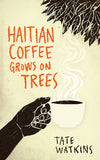

What Haiti’s tall coffee trees reveal about the country, its history, and—perhaps—its future
Apr 20, 2019 (Updated on May 23, 2019)
by Tate Watkins
The following excerpt is adapted from Haitian Coffee Grows on Trees, my short book that uses coffee as a vehicle to explore how things work, or often don’t, in Haiti. After living in the country for four years working as a journalist and later with small-scale coffee farmers, I tried to outline how, despite the fact that Haiti isn’t set up in a way that would help everyday people flourish, small changes still have the potential to add up to real improvements in the lives of ordinary Haitians. The book is available now in paperback and Kindle versions
COFFEE GROWS ON TREES
For a couple of years I thought that the semi-wild, half-forgotten coffee I’d seen growing in the mountains across Haiti was a recent development. In some places, small mountain houses are dwarfed by 60-year-old coffee trees that produce literally two cherries. And in Haiti, the joke is that if a tree still gives a single cherry, a farmer will not touch it with a machete to prune it, lest he lose the income that single cherry represents, minuscule as it may be. So he leaves it for another year, withering like a nursing home patient who’s been forgotten in the corner of the game room and missed a week of meals... Continue reading @ Tate's Medium



